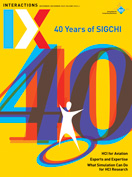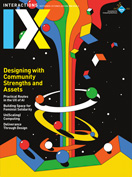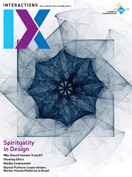Authors:
Adriana S. Vivacqua
Over the years, SIGCHI has evolved its global presence, something it's had since its founding in the U.S. in the early 1980s. In this article, using reports in the SIGCHI Bulletin [1], we trace the history of SIGCHI's global presence, efforts, and initiatives through the years, closing with the current state and initiatives from the SIGCHI Executive Committee (EC).
→ Being an international organization has always been important to SIGCHI.
→ Many projects have been undertaken throughout the years to increase global participation in SIGCHI activities.
→ The current EC is committed to internationalization and has a number of initiatives to support our global community.
In the second issue of the Bulletin (October 1982, vol. 14), SIGCHI Chair Lorraine Borman mentions that its members come from 40 countries, revealing that SIGCHI was a global community from the start (even if some countries had very few members). Canada (27 members), Germany (22 members), and Japan (17 members) were the countries with the highest number of members after the U.S.
Tracking CHI attendance is another useful way to get a sense of how global SIGCHI was at different points in time. For instance, the April 1984 Bulletin (vol. 15) reported that 89 percent (871) of the CHI '83 registrants were from the U.S., 6 percent from Canada, and 5 percent from Europe. Fifty-four percent were from Massachusetts, California, New Jersey, or New York.
Early on, SIGCHI leadership recognized the importance of partnering with other organizations. The October 1984 Bulletin (vol. 16) mentions that the Interact '84 conference, held in London and sponsored by IFIP in cooperation with SIGCHI, drew a large global audience: 517 attendees from Great Britain, Europe, Australia, Japan, and the U.S.
The same issue acknowledges the newly formed Human-Computer Interaction Group in the British Computer Society, showing that SIGCHI was also interested in connecting with and celebrating sister organizations beyond U.S. borders:
The British Computer Society has formed a new HUMAN-COMPUTER INTERACTION GROUP. Chaired by Nigel Bevan (National Physical Laboratory, DITC, Teddington, Middlesex TW11 OLW, UK), the group has been "set up to enable researchers, users, and designers to meet and learn more about how human factors principles can be incorporated into systems design." The group is not restricted to members of BCS.
In 1986, five years after SIGCHI was first formed, the first Local SIGCHI Group—now known as SIGCHI Chapters—was started in Boston. From the October 1986 Bulletin (vol. 18):
We are happy to welcome the first local SIGCHI group—the Greater Boston Special Interest Group on Computer and Human Interaction. Kate Ehrlich is Chair, Wendy Mackay, Vice-Chair, and Newsletter efforts are shared by Sharon Smith and Linda Evers. If you are in that area, call Mike Dean about membership information.
Local groups were important to help people connect and promote communities of like-minded people who were geographically close. These were grassroots initiatives by people wanting to organize events and promote HCI in their areas, and there were many people eager to connect:
I continue to receive calls from people looking for other local SIGCHIs. The National SIGCHI cannot start these groups—they must be developed by local people. However, we can provide information on how to form a group, rules and regulations of such groups, and a minimal amount of seed money. For more information, contact Kate Ehrlich, SIGCHI Secretary/Treasurer.
The year 1987 turned out to be important for SIGCHI globalization. Acknowledging its sizable global audience, in the October Bulletin (vol. 19) SIGCHI named Jakob Nielsen as an international correspondent. Nielsen started his first piece by restating this intent and then wrote two pieces about European research projects:
The SIGCHI Bulletin would like its readers to be better informed about events in the CHI field in Europe. It is my job as European editor to try to see this done. We start in this issue with an article about the large HUFIT research project sponsored by the European Community as part of the ESPRIT 1 program.
Nielsen's reporting would help members become aware of what was going on in other corners of the world. Over time, he wrote multiple pieces, from conference reports to descriptions of European labs and projects, turning the spotlight on research being done outside the U.S. In addition, the April 1988 Bulletin (vol. 19) features a summary of the minutes of SIGCHI's first long-range planning meeting, where internationalization is explicitly mentioned at a strategic level, as far as we could tell, for the first time. The summarized minutes of the SIGCHI Long-Range Planning Meeting November 22, 1987, mention "CHI treated as an international field" and "SIGCHI outreach—international organization."
The following issue, July 1988 (vol. 20), shows that SIGCHI was willing to act on this strategy, mentioning a proposal to hold a conference in Europe for the first time. This conference would turn out to be CHI '93 (aka INTERCHI), held April 23–29 in Amsterdam, in conjunction and jointly organized with INTERACT. The October 1989 Bulletin (vol. 21) has some details about this organization process:
A site visit team (Lorraine Borman, Rob Jacob, and Don Patterson) visited Amsterdam this past June and met with various representatives of European organizations and a conference management services firm. Much of the groundwork had been done during meetings at CHI '89; the Minutes of the May '89 meeting in this issue highlight these discussions.
This decision is only one of the many steps that will make INTERCHI '93 (the current working conference title) happen. Negotiations with our European colleagues will continue. The EC is very pleased that the Nederlands Genootschap voor Informatica (NGI), IFIP/INTERACT, CHI, and NOVEP (a Netherlands conference organizing firm) are committed to bringing you the first CHI conference outside North America.
The same issue has the longer version of the EC meeting minutes, which details the complexity and care that went into organizing the first CHI outside North America. Interested Europeans were invited to discuss the organization and how to better integrate the communities. Elements such as increased U.S. participation in European conferences and publishing contracts were some of the items discussed. Partnering with other organizations—IFIP WG6.3 and NGI—was another key element in this event:
The move to Europe presented an opportunity to change the style of the conference to something less formal, involving posters and other forms of presentation.
The CPC formally invited interested Europeans to meet at CHI '89 to discuss holding CHI '93 in Amsterdam. 30–40 people met Tuesday and two working meetings were held Wednesday… Proposed is that the Conference be called INTERCHI and be held April 24–29, 1993, with SIGCHI and IFIP WG6.3 as sponsors and the Dutch Computer Society (NGI) as host society. Several tentative cooperating societies were identified.
Peter Stevens writes about INTERCHI in the January 1993 Bulletin (vol. 25) and how holding it outside of North America will benefit the SIGCHI community by bringing a different take on HCI that was being developed in Europe, and increased European participation:
Participants in INTERCHI '93 will find it a unique conference in SIGCHI's history, reflecting differences in both technical content and the style of the conference due to an increase in European participation.
In several areas European user interface work has a broader focus, going beyond the more usual office automation tasks to many more embedded systems applications such as controls for ferry boats and mining equipment.
Combined with regulations requiring user participation in the design process, the result is a significantly different European attitude towards the HCI process. These differences are summed up by [Susan] Dray: "European UI designers, because they see wide differences in their user community, tend toward more experimentation and user involvement in the design process. It's not that North American designers don't do this, but that there is a difference in emphasis." All over the world such extension of user interface technology into the total work environment is becoming critical.
Non-North American attendance at CHI '92 was only 300 out of 2,600; that number was expected to increase significantly for INTERCHI in '93. The move to Europe also presented an opportunity to change the style of the conference to something less formal, involving posters and other forms of presentation, in addition to bringing in distinct topics and styles of research. All of this was expected to enrich the experience for the whole community. But it wasn't all praise, and there were complaints that members from the U.S. might find it harder to travel to the EU to participate in the conference due to cost and to the need for work approval. Prior to holding INTERCHI in Europe, the SIGCHI EC established an international chair position within SIGCHI (Bulletin, April 1993, vol. 24):
INTERCHI '93 represents a major step in the internationalization of SIGCHI, but it is not viewed as a one time effort to meet with a wider audience of HCI professionals. Efforts will continue within our society reach across national borders. An important part of these ongoing efforts was the establishment of an International Chair position within SIGCHI. This position is currently co-held by Dianne Murray and Brad Hartfield.
In the October 1993 Bulletin (vol. 25), Andy Cargill reports on INTERCHI in a favorable light, noting that "INTERCHI '93—the first combined European INTERACT and American SIG-CHI conference—was for me very much like Amsterdam itself: extremely open-minded and eye-opening. I learned as much from the many colleagues I talked to as from the actual material itself."
It should also be noted that the Bulletin published many pieces describing the state of research and practice outside of North America, which helped members stay abreast of current developments in other countries.
After INTERCHI, internationalization became a recurring theme, as noted by Steven Pemberton when he took up the role of Bulletin editor in January 1994 (vol. 26):
Going international is a leading theme in SIGCHI's development aims, indeed of ACM as a whole, and featuring internationalism is all the more fitting for me since, considering my location (here in Amsterdam), I'm having to learn very quickly what it means to work in a multi-national organisation: hour-long international phone calls; trying to find out what timezone someone is in, or when day-light saving changes, so that I don't go and wake them up, or so that when they ask me to phone at 10.30, I actually know what that means; the problems of getting material across the ocean in a time frame of less than a number of months; transferring money internationally; spell-checking articles written by people from different spelling regions.
While technology has alleviated some of these issues, we still face many of them when dealing with global groups and teams and have many of the same concerns. Shortly after INTERCHI, SIGCHI started working with ACM to set up a fund to develop multiyear activities using its budget surplus, in the model of the ACM Development Fund. The SIGCHI Development Fund was approved in 1995. According to the meeting minutes published in the October 1995 Bulletin (vol. 27):
The fund allocates resources for all members. Its purpose is to advance HCI. The SIGCHI Bulletin will have a call for proposals. The fund is intended to support high quality work and communication of that work. Starting July 1, 1995 $20k is available. The funds available will be set in the annual SIGCHI budget and may vary from year to year.
One of SIGCHI's goals became to "make SIGCHI the focal point for HCI to the world" (January 1996, vol. 28), and the Bulletin gained an International Perspectives column, later renamed World Wide CHI. Many pieces in the Bulletin acknowledge the need to connect to communities across the world and the challenges that poses. There are also many mentions of sister organizations, global (IFIP, for example) and local (e.g., British HCI group), and the desire to partner with those to advance HCI around the world. Chapters (then called Local SIGs) blossomed and became an important way for communities to organize locally around the topic of HCI.
The Chair's Column in the January 1987 Bulletin (vol. 18), by Lorraine Borman, features a membership table (Figure 1). While there are many countries listed, only 20 percent of members are not from the U.S. In contrast, in the July 1999 Bulletin (vol. 31), Marilyn Tremaine writes:
 | Figure 1. Membership table from the January 1987 issue of the SIGCHI Bulletin. |
Although the home office for SIGCHI, that is, ACM's headquarters in New York City, is American, nearly fifty percent of SIGCHI members are from countries other than the U.S. We view this as a healthy change and encourage the growth of multi-national and therefore, multi-cultural composition within SIGCHI. SIGCHI has long held in balance the stresses and strains between technologists and humanists, practitioners and researchers, engineers and artists. Its multi-national nature should do nothing but enrich this already rich collection of members.
That's quite a bit of growth in just over 10 years, thanks to the continued commitment of SIGCHI leadership. In 2003, a special issue of Interactions collected a set of pieces by Global South researchers under the theme "Winds of Change" [2]. In the editorial, Steven Pemberton remarks on the growth of local chapters (66 across the world), and how the community had become truly international. This issue highlighted initiatives and communities not usually seen at SIGCHI conferences, showing how rich and diverse the work being conducted there is.
Looking back at the first years of SIGCHI, it seems clear that internationalization was embraced as a goal as soon as its internal organization was sorted out. Steady efforts have been made throughout the years to build and support HCI worldwide.
We continue this commitment through incentives for conferences to travel to new locations (especially in the so-called Global South) and through initiatives to make our conferences more accessible to global audiences. These include setting up regional committees to discuss and address local/regional challenges and articulate efforts within a geographic region; allocating funds to help members from distant countries, specifically students, travel to our conferences; strengthening chapter presence; allocating funding for grassroots local initiatives; and setting up partnerships with local/regional sister organizations. With these and other initiatives, we hope to see SIGCHI become even more international than it already is.
1. SIGCHI Bulletin: https://dl.acm.org/newsletter/sigchi
2. Winds of change. Interactions 10, 2 (Mar.–Apr. 2003); https://interactions.acm.org/archive/toc/march-april-2003
Adriana S. Vivacqua is a professor at the Institute of Computing of the Federal University of Rio de Janeiro and currently serving as VP at large on the SIGCHI EC. She investigates how technology can support collaboration, particularly as it relates to group awareness and information distribution. [email protected]
©2022 ACM 1072-5520/22/11 $15.00
Permission to make digital or hard copies of all or part of this work for personal or classroom use is granted without fee provided that copies are not made or distributed for profit or commercial advantage and that copies bear this notice and the full citation on the first page. To copy otherwise, to republish, to post on servers or to redistribute to lists, requires prior specific permission and/or a fee.
The Digital Library is published by the Association for Computing Machinery. Copyright © 2022 ACM, Inc.







Post Comment
No Comments Found